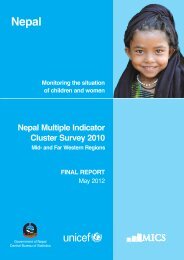Small Area Estimation of Poverty
Small Area Estimation of Poverty
Small Area Estimation of Poverty
- No tags were found...
You also want an ePaper? Increase the reach of your titles
YUMPU automatically turns print PDFs into web optimized ePapers that Google loves.
5. How reliable are these maps?5.1 tests for over-fittingTo ascertain that the coefficients estimated with the betaand alpha models capture the general relationshipsbetween expenditure and observables, rather than beingonly relevant for a limited set <strong>of</strong> survey households,all regions are subject to over-fitting tests. They arecarried out in accordance with their description in themethodology section. Thus, estimating the modelson a 50% subsample <strong>of</strong> the region, following the ELLmethodology, and comparing the predicted results inthe other 50% subsample with observed expenditure inthat sub-sample. Meanwhile, variables that were foundinsignificant on the first subsample were excluded fromthe models. Table 4 shows the results <strong>of</strong> this exercise. Thepredicted and observed FGT(0) is presented by the threeregions for which we have separate models, as well as bystrata within those regions. Z-values for all 22 categoriesare below the absolute value <strong>of</strong> two, suggesting thatour models are not over-fitting. Note that for the subregionalcategories, these Z-values must be taken with agrain <strong>of</strong> salt as their low number <strong>of</strong> observations (abouthalf <strong>of</strong> their normal stratum size, or less) may cause theconfidence interval to be relatively wide. But regardless,just looking at the total <strong>of</strong> the three regions gives usconfidence in the estimated results with Z-values <strong>of</strong>0.002, 1.016 and 0.220 for respectively Central&Eastern,Western, and Midwestern & Farwestern.Table 4: Over-fitting test comparing observed and predicted FGT(0) in a subsample <strong>of</strong> the NLSS3 surveyObserved FGT(0) in subsample 2 (survey Predicted FGT(0) in subsample 2Strata: N Mean S.E. mean Mean S.E. mean Z-valueCentral & Eastern region:Mountain 127 0.205 0.036 0.152 0.016 -1.330Urban-Kathma 422 0.104 0.015 0.134 0.008 1.744Urban-Hill 73 0.082 0.032 0.109 0.018 0.736Rural-Hill-Eastern 192 0.130 0.024 0.180 0.015 1.727Rural-Hill-Central 239 0.188 0.025 0.154 0.014 -1.175Urban-Terai 199 0.156 0.026 0.158 0.015 0.081Rural-Terai-Eastern 233 0.180 0.025 0.164 0.014 -0.564Rural-Terai-Central 237 0.215 0.027 0.191 0.014 -0.810Total Central & Eastern region 1722 0.157 0.009 0.157 0.005 0.002Western region:Urban-Hill 116 0.009 0.009 0.020 0.005 1.139Rural-Hill-Western 246 0.211 0.026 0.233 0.016 0.689Urban-Terai 45 0.089 0.043 0.079 0.026 -0.207Rural-Terai-Western 169 0.166 0.029 0.191 0.018 0.742Total Western region 576 0.148 0.015 0.166 0.010 1.016Midwestern & Farwestern region:Mountain 82 0.451 0.055 0.505 0.029 0.856Urban-Hill 37 0.189 0.065 0.252 0.039 0.820Rural-Hill-Midwestern 181 0.293 0.034 0.325 0.018 0.839Rural-Hill-Farwestern 87 0.414 0.053 0.354 0.027 -1.000Urban-Terai 88 0.295 0.049 0.270 0.029 -0.450Rural-Terai-Midwestern 125 0.192 0.035 0.222 0.022 0.712Rural-Terai-Farwestern 78 0.372 0.055 0.298 0.029 -1.181Urban-Terai 88 0.295 0.049 0.270 0.029 -0.450Rural-Terai-Midwestern 125 0.192 0.035 0.222 0.022 0.712Rural-Terai-Farwestern 78 0.372 0.055 0.298 0.029 -1.181Total Midwestern & Farwestern region 678 0.313 0.018 0.317 0.010 0.220Presenting observed and predicted poverty in a random subsample <strong>of</strong> the survey by stratum, where the predicted poverty rate is based ona consumption model calibrated on the other half <strong>of</strong> the survey data (“subsample 1”). Z-value = ( FGT(0) census - FGT(0) survey ) / √[ (S.E.census)2 + (S.E. census)2]. The value <strong>of</strong> Z should thus not exceed │2│for both measures to represent the same poverty incidence. Source: NLSSIII.NEPAL <strong>Small</strong> <strong>Area</strong> <strong>Estimation</strong> <strong>of</strong> <strong>Poverty</strong>, 2011, Summary and Major Findings 13
















